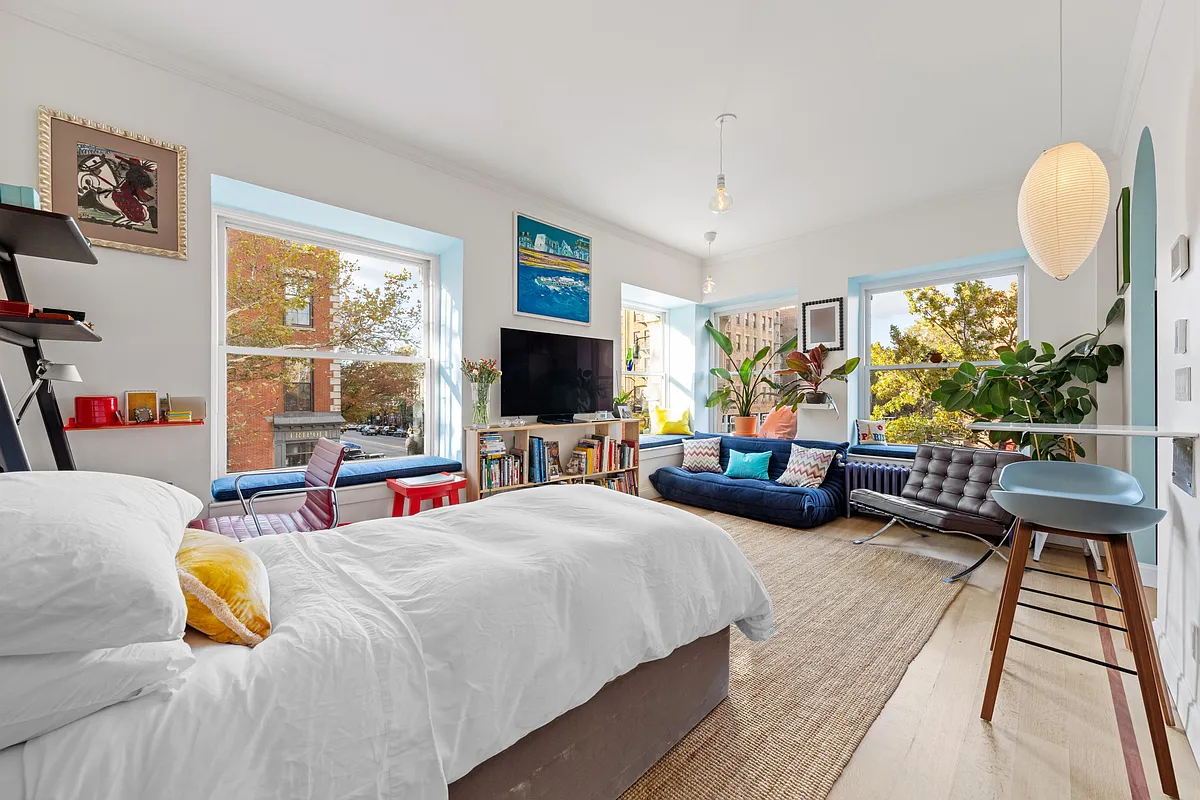Successful Modern Reno in Historic Context
Though we’d seen it already as part of the modern exhibit on the Fort Greene House Tour, we enjoyed today’s House & Home article on the modern reno of the small Adelphi Street house. We think this is a wonderful example of successful modern design. Given the scale of the house, the modern approach–particularly in…


Though we’d seen it already as part of the modern exhibit on the Fort Greene House Tour, we enjoyed today’s House & Home article on the modern reno of the small Adelphi Street house. We think this is a wonderful example of successful modern design. Given the scale of the house, the modern approach–particularly in the use of windows and light–works far better than what was there before. (The second floor ceilings were only 7-feet high before.) We bet everyone will be particularly interested to see that the architect couple, Margarita McGrath and Scott Oliver, who own the house managed to do the entire renovation for only $135 a foot, another example of how a professional can cut corners, call in favors, etc. to get his/her own place done for cheap.
Designing a House to Save a Tree [NY Times]





The concept Zipper has been around for quite a while:
Elias Howe, who invented the sewing machine received a patent in 1851 for an ‘Automatic, Continuous Clothing Closure.’
Perhaps it was the success of the sewing machine, which caused Elias not to pursue marketing his clothing closure. As a result, Howe missed his chance to become the recognized ‘Father of the Zip.’
Forty-four years later, Mr. Whitcomb Judson (who also invented the ‘Pneumatic Street Railway’) marketed a ‘Clasp Locker’ a device similar to the 1851 Howe patent. Being first to market gave Whitcomb the credit of being the ‘Inventor of the Zipper’, However, his 1893 patent did not use the word zipper. The Chicago inventor’s ‘Clasp Locker’ was a complicated hook-and-eye shoe fastener. Together with businessman Colonel Lewis Walker, Whitcomb launched the Universal Fastener Company to manufacture the new device. The clasp locker had its public debut at the 1893 Chicago World’s Fair and met with little commercial success.
Swedish-born (who later immigrated to Canada), Gideon Sundback, an electrical engineer, was hired to work for the Universal Fastener Company. Good design skills and a marriage to the plant-manager’s daughter Elvira Aronson led Sundback to the position of head designer at Universal. He was responsible for improving the far from perfect ‘Judson C-curity Fastener.’ Unfortunately, Sundback’s wife died in 1911. The grieving husband busied himself at the design table and by December of 1913, he had designed the modern zipper.
http://inventors.about.com/library/weekly/aa082497.htm
me, i don’t let anybody wearing polyester enter my brownstone, cause polyester wasn’t invented in “the golden time.” ditto electronic devices of all kinds. especially irksome are the zipper wearers. buttons are fine. just fine.
I suppose it all depends on how comfortable an individual is with imagination and departure from tradition, as well as new forms that arise from new technologies and lifestyles.
Some of us have a more difficult departing from tradition than others.
I agree with Ed a thousand percent. Brownstone literalists are like the Civil War re-enacters of architecture.
Ugly suburban great rooms, by the way, have nothing to do with good modernist design. Actually the opposite. Your average suburban new-home buyer would hate this house more than the brownstone purists do. (“It’s so boxy! So small! It’s doesn’t look homey! And the windows — they can see right in your house!”)
In fact, your typical McMansion is an absolute rejection of modernism, a vulgar, anachronistic, gingerbread mix of pre-modernist period styles–dormers piled on top of gables, a little Tudor this, a little Victorian that, etc.
This is an interesting house. I used to live on Myrtle near the corner of Adelphi and would often walk by this house. It confused me because although it has a modern appearance, by design and materials, it always looked old and slightly run down to me. It seems to me that the materials just don’t hold up visually. They get easily dirty and consequently ugly, and look cheap to me at the end of the day. I’d also add that many of the comments in the article seem comically generic and cliche to me at this point, and this whole business about saving a tree is silly. Why didn’t they build around a courtyard for the tree for instance? Finally, who want’s to buy a house and live in 600 square feet?!??
Uh the house was a dump (I remember seeing it when I was on the market). That said I was more struch by having an open grate floor above your bed. Wouldn’t all the mud from your shoes fall in your bed? Do you really want to walk into a house and see the bed first thing (okay I guess it would depend with whom you entered). Very idiosynchratic, but I guess they love it.
Sorry for the multiple posts! I kept getting an error message, so I didn’t think I was getting through.
I see we have a purist here. Frankly, just because you live in a brownstone doesn’t mean you have to live like people did in 1900. Should all go out and get servants and dumbwaiters too?
Times change and old homes decay. Modern home design means using the technologies and addressing the needs of today.
I’m not advocating destroying a beautiful historic interior by any means, but if your brownstone lacks interior details or has been damaged or is grossly impractical, then a tasteful, well-thought contemporary renovation (like this one) is a totally viable solution.
p.s. – I’ve seen many brownstones with contemporary “open plan” renovations, and they tend to be GORGEOUS.